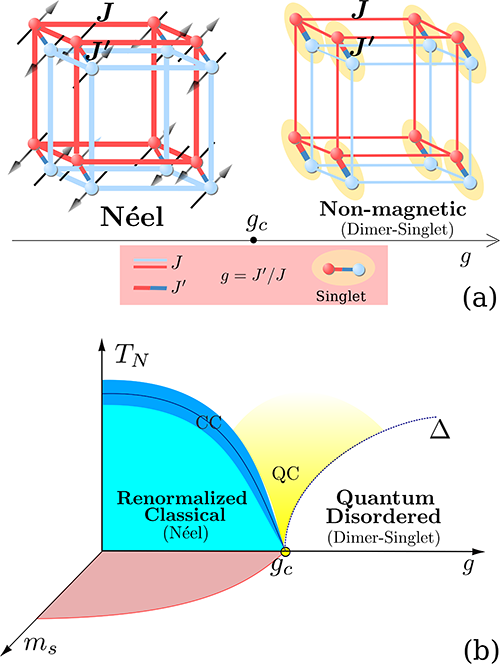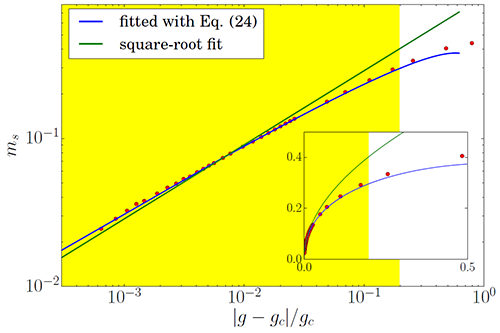Multiplicative logarithmic corrections to quantum criticality in three dimension is confirmed by large-scale quantum Monte Carlo simulations
Date:10-12-2015 Print
Critical phenomena are ubiquitous in all of physics, appearing in their distinct and universal forms at every phase transition. Quantum critical phenomena are equally universal but far more enigmatic, causing a system described by a microscopic, quantum Hamiltonian to be governed only by its most macroscopic properties (the dimensions of space and of the order parameter). Experimental studies of quantum critical phenomena are inordinately difficult, due to the need for fine control over both the temperature and a quantum tuning parameter in the region of a quantum critical point. However, recent studies of the pressure-induced magnetic quantum phase transition in dimerized antiferromagnets have rekindled intense interest in a number of long-standing questions, both qualitative and quantitative, about quantum criticality.
These questions include the interplay of independence of quantum and thermal fluctuations in the quantum critical regime, the strength of the multiplicative logarithmic corrections at the upper critical dimension and the (nonuniversal) constants of proportionality affecting the experimental visibility of the phenomena, including the width of the quantum and thermal critical regions. All of these issues are closely related and we provide answers to all of them by performing a systematic numerical investigation of the quantum phase transition in a 3D S = 1/2 dimerized Heisenberg antiferromagnet. This model is a direct analogue of the quantum magnet TlCuCl_3, in which detailed experiments have measured the properties of the critical regime around the pressure-controlled quantum phase transition.
This system is at the upper critical dimension, where the dominant qualitative phenomenon predicted by field-theoretical approaches is logarithmic corrections to the mean-field scaling properties of all physical observables. These corrections reflect the incipient entanglement of quantum and thermal fluctuations. The quantitative study of logarithmic corrections is an inordinately difficult task due to their weak functional forms and strong sensitivity to error bars and exact extrapolations, and so requires extremely high numerical precision. Several studies in the past have failed to find meaningful evidence for their presence, calling into question both the constants of proportionality involved and the overall theoretical framework.
With the specific target of characterising the logarithmic corrections, Prof. Zi Yang Meng's group in IOP (including graduate student Yan Qi Qi and Zi Yang Meng) in collaboration with Prof. Bruce Normand from Renmin University of China and Prof. Anders Sandvik from Boston University in US, have performed very large-scale quantum Monte Carlo simulations with state-of-the-art algorithms and methods, allied with high-precision finite-size extrapolations, to approach points unprecedentedly close to the quantum phase transition. Our results allow us to extract precise multiplicative logarithmic corrections to the leading mean-field critical properties in the 4D O(3) universality class of the model. We provide the first exact numerical verification of the logarithmic corrections predicted for the order parameter (the zero-temperature staggered magnetization). Deriving a scaling ansatzfor the ordering temperature T_N away from the quantum-critical point (which was not previously available with logarithmic correction included), we alsodemonstrate that T_N obeys exactly the same logarithmic form as the sublatticemagnetization at zero temperature. This entirely new result, the exact linearity of a ``quantum'' and a ``thermal'' quantity throughout the phase diagram, wasunexpected and we discuss its implications. The nature of our finite-size data also allow us to demonstrate the predicted logarithmic corrections in the size scaling of the magnetic susceptibility, verifying the field-theoretical connection from partition-function zeros to thermodynamic observables, including notonly the multiplicative log correction but also a subleading correction.
These results are of interest to a broad cross-section of the physicscommunity, spanning theory, numerics and experiment in hard and soft condensed matter, cold atoms, field theory and high-energy physics. They lie beyond the limits of what was previously possible and open new horizons in the quantitative study of quantum criticality.
This study entitled “Multiplicative logarithmic corrections to quantum criticality in three-dimensional dimerized antiferromagnets” was published on Phys. Rev. B 92, 214401(2015).
http://journals.aps.org/prb/abstract/10.1103/PhysRevB.92.214401
This work was supported by theNational Natural Science Foundation of China under Grant No. 11174365, and by the National Basic Research Program of China under Grant No. 2012CB921704 (B.N.). The simulations were carried out at the National Supercomputer Center in Tianjin on the platform TianHe-1A.A.W.S.was supported by the NSF under Grant No. DMR-1410126, by the Simons Foundation, and by the Center for International Collaboration at the Institute of Physics of the Chinese Academy of Sciences.
 |
| Fig.1 (a) Dimerized lattice of S = 1/2 spins in the 3D double cubic geometry. Sites of the red and blue cubic lattices are connected pairwise by dimer bonds J'and J are antiferromagnetic Heisenberg interactions on and between the dimer units, respectively, and their ratio, g=J'/J, controls the QPT from a Neel ordered phase (left) to a quantum disordered dimer-singlet phase (right), with the QCP occurring at the critical ratio gc. (b) Schematic quantum critical phase diagram for the Heisenberg model on the double cubic lattice. On the ordered “renormalized classical” side, g<gc, the Neel order is progressively weakened by increasing quantum fluctuations as g approaches gc, causing both the ordering (Neel) temperature TN(g) and the order parameter (the staggered magnetization) ms(g) to go continuously to zero. On the “quantum disordered” side, intradimer correlations dominate, and the characteristic energy scale is the gap to triplet excitations. Above gcat T>0 is the universal “quantum critical” (QC) region, whose behavior is governed by the (3 + 1)-dimensional O(3) universality class. Around TN(g), one expects a region of classical critical (CC) behavior where thermal fluctuations are dominant. (Image by Yan Qi Qin from Institute of Physics) |
 |
| Fig.2 Extrapolated staggered magnetization ms at T = 0 as a function of the distance from the QCP. The closest point to gc is g = 4.834 (with gc=4.837). Lines show both the best fit by a pure square-root function [green] and including the predicted logarithmic corrections [Eq. (24) blue]. The yellow shading represents the approximate extent of the QC regime and is determined by including all data points described adequately (within a deviation of approximately 4%) by the functional form of the logarithmic correction curve. The inset shows ms(g) and the QC regime on linear axes. (Image by Yan Qi Qin from Institute of Physics) |
 |
| Fig.3 Normalized Neel temperature TN/Jsas a function of the distance from criticality |g-gc|. The closest point to gc =4.837 is g = 4.831. Lines show both the best fit by a pure square root function (green) and using a logarithmic correction factor with exponent (blue). The yellow shading represents the QC regime. The inset shows TN(g) on linear axes. (Image by Yan Qi Qin from Institute of Physics) |
Contact:
Institute of Physics
Zi Yang Meng
Email:zymeng@iphy.ac.cn
Key word:
Quantum phase transition, quantum critical point, logarithmic corrections, quantum Monte Carlo simulations
Abstract:
Multiplicative logarithmic corrections to quantum criticality in three dimensional dimerized antiferromagnets is confirmed by large-scale quantum Monte Carlo simulations.

